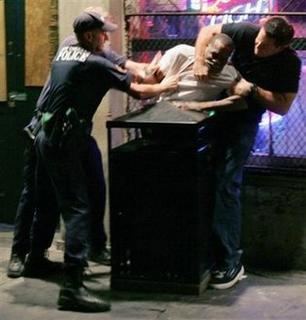Investigators Link Levee Failures to Design Flaws
Three Teams of Engineers Find Weakened Soil, Navigation Canal Contributed to La. Collapses
By Joby Warrick and Michael Grunwald
Washington Post Staff Writers
October 26, 2005
NEW ORLEANS -- Within a space of 15 hours on Aug. 29, three massive, concrete floodwalls in separate parts of the city suddenly fractured and burst under the weight of surging waters from Hurricane Katrina. The breaches unleashed a wall of water that swept entire buildings from their foundations and transformed what might have been a routine hurricane into the costliest storm in U.S. history.
Today, exactly eight weeks after the storm, all three breaches are looking less like acts of God and more like failures of engineering that could have been anticipated and very likely prevented.
Investigators in recent days have assembled evidence implicating design flaws in the failures of two floodwalls near Lake Pontchartrain that collapsed when weakened soils beneath them became saturated and began to slide. They also have confirmed that a little-used navigation canal helped amplify and intensify Katrina's initial surge, contributing to a third floodwall collapse on the east side of town. The walls and navigation canal were built by the U.S. Army Corps of Engineers, the agency responsible for defending the city against hurricane-related flooding.
The preliminary findings -- based on physical evidence, Corps documents and hydrodynamic models run through a Louisiana State University supercomputer -- are the work of three teams of engineers and forensic experts conducting separate probes. The investigations are shedding light not only on the cause of the failures but also the scale of the rebuilding effort: The discovery of major flaws in the design of the city's levees and floodwalls could add billions of dollars to the cost of New Orleans' recovery.
Investigators already have rejected the initial explanation offered by Corps officials in the hurricane's aftermath that massive storm surges had overtopped and overwhelmed floodwalls on the 17th Street and London Avenue canals on the north side of town. The new findings for the first time point to a human role in all three of the major floodwall failures that left about 100,000 homes underwater and caused most of Louisiana's approximately 1,000 hurricane deaths.
Experts now believe that Katrina was no stronger than a Category 3 storm when it roared into New Orleans, and Congress had directed the Corps to protect the city from just such a hurricane.
"This was not the Big One -- not even close," said Hassan Mashriqui, a storm surge expert at LSU's Hurricane Center. He said that Katrina would have caused some modest flooding and wind damage regardless, but that human errors turned "a problem into a catastrophe."
The National Science Foundation, the American Society of Civil Engineers, and the state of Louisiana are all conducting investigations of the three major floodwall breaches and dozens of smaller ones. Defense Secretary Donald H. Rumsfeld announced last week that the National Academies of science and engineering will lead a separate probe. The Corps has offered data and other assistance to the independent inquiries, but the agency has declined to speculate on the causes of the tragedy.
John Paul Woodley Jr., the assistant Army secretary overseeing the Corps, said it is still too early to cast blame for the drowning of New Orleans. But he said the Corps intends to learn from the Katrina investigations, and use the lessons to build stronger protections for the city.
"I'm not afraid of finding out the truth," Woodley said.
The independent investigations have pointed to two failures in the infrastructure maintained by the Army Corps of Engineers that were critical factors in the destruction Katrina wrought in New Orleans.
In 1965, the Corps completed the 76-mile-long, 36-foot-deep Mississippi River Gulf Outlet, a larger dirt-moving project than the Panama Canal. The outlet -- known locally as MRGO, or "Mr. Go" -- created a navigation shortcut to the Port of New Orleans, although a little-used one that averages fewer than one ship a day. But the outlet also amounted to a funnel that would accelerate and enlarge any storm surges headed for the city's levees.
Three months before Katrina, Mashriqui told a room full of emergency managers that the outlet was a "critical and fundamental flaw" in the Corps' hurricane defenses, a "Trojan Horse" that could amplify storm surges 20 to 40 percent.
With the help of a supercomputer, Mashriqui has now concluded that the effect was even worse than he predicted.
The analysis shows that the outlet's "funnel" intensified the initial surge by 20 percent, raising the wall of water about three feet. But it also increased the velocity of the surge, which Mashriqui believes contributed to the scouring that undermined the levees and floodwalls along the outlet and Industrial Canal. He found that Katrina's surge moved through nearby Lake Borgne at less than 3 feet per second. But the rate was about 6 feet per second at the mouth of the funnel, and as much as 8 feet per second in the funnel.
Mashriqui also found that in the areas where the outlet had wiped out marshes and other wetlands, levees and floodwalls were much more likely to fail. In areas where the natural buffers remained, the manmade defenses held, even when they were overtopped.
"Without MRGO, the flooding would have been much less," he said. "The levees might have overtopped, but they wouldn't have been washed away."
Corps officials declined comment on the results of the modeling. But Corps spokesman Jason Fanselau said the agency's own data still point to a massive surge that exceeded the height of the Industrial Canal floodwall by more than a few feet.
"Katrina flat-out overwhelmed the system," he said. "There was a huge wall of surge that obliterated entire sections of the floodwall."
In the case of the 17th Street and London Avenue canals, the independent investigators believe the floodwalls themselves were the problem. The reason was the naturally soft soil made up of river silts and swampy peat that has been the bane of builders here for two centuries.
Investigators now believe the walls collapsed when the soils beneath them became saturated and began to shift under the weight of relatively modest surges from the lake. And newly released documents show that the Corps was aware years ago that a particularly unstable layer of soil lay beneath both floodwalls.
"These levees did not overtop, yet they failed anyway," said Peter Nicholson, an engineering professor at the University of Hawaii at Manoa and leader of the ASCE investigating team. "It's important that we find out now exactly what went wrong, because the Corps is already starting to rebuild."
Documents given to investigators by former Corps contractors have shed some light on what government engineers knew about the weak soils and how this knowledge affected their decisions.
In the 1980s, the Corps began constructing concrete floodwalls on top of older earthen levees to give the city's northern neighborhoods better protection from storm surges from Lake Pontchartrain. Soil tests in the 1980s detected trouble 20 feet below the surface: a thick layer of spongy, organic soil called peat. Soft and highly compressible when dry, peat becomes even weaker when saturated with water.
A 1988 document reveals that Corps officials took careful measurements of the peat layer and tested the soil in a laboratory to calculate its relative strength, according to Robert Bea, a professor of engineering at the University of California at Berkeley and a member of the NSF investigating team. Based on those calculations, the Corps designed a concrete-and-steel floodwall anchored to the earth by steel pilings driven to a depth of 20 feet.
"The depth of the pilings becomes important," said Bea, because the "tips of the sheet piles may not have penetrated the peat." Meanwhile, because the canal was dredged to an even greater depth, water was able to penetrate the peat layer from the inside, investigators said.
"There was a gap where water could get through," said Ivor Van Heerden, the deputy director of the LSU Hurricane Center and the leader of the Louisiana forensic investigation. "Water was able to get around or through those pilings to the other side and start weakening the structure."
Reports of problems with the soft underlayer began to surface even before the floodwalls were finished. In 1994, the now-defunct Pittman Construction Co., a New Orleans firm involved in levee construction, claimed in court documents that floodwall sections were failing to line up properly because of unstable soils. An administrative law judge dismissed the complaint on technical grounds in 1998, without specifically addressing the allegations about weak soils.
Katrina's storm surge put the floodwalls to the ultimate test.
Hours after the storm hit, water poured into the canals from Lake Pontchartrain and added enormous strain to the walls and levees. According to a scenario developed by Bea and other investigators, the already-saturated peat was the path of least resistance, allowing the water to burst through the wall from underneath. At the 17th Street Canal, truck-size chunks of the old earthen levee were heaved 35 feet on a carpet of sliding soil.
Corps officials are not yet convinced. "It is important not to jump to conclusions," said John Grieshaber, chief of the engineering division in the Corps' New Orleans district office. "It's hard to look at the aftereffects and say with a high level of certainty, 'This is what happened.' "
The Corps' actions since the storm, however, suggest that at least some officials are worried about weaknesses in the floodwalls' design. A proposal for rebuilding the floodwalls has set far tougher standards than existed 15 years ago. And the steel pilings, which formerly reached a depth of 20 feet, must now be driven through the peat layer to 40 feet, twice as deep as before.
If design flaws are confirmed, the task of preparing the 200-mile levee system for the next hurricane may be far more complex -- and more expensive -- than first believed, said Gordon Boutwell, president of Soil Testing Engineers Inc. and a member of the ASCE investigative team.
"Nothing beats a full-scale field test, and this was a full-scale field test," Boutwell said. "Some structures did the job they were supposed to, but some were total failures -- and those you can't just leave alone. And you can't expect to just stack them higher and walk away."














